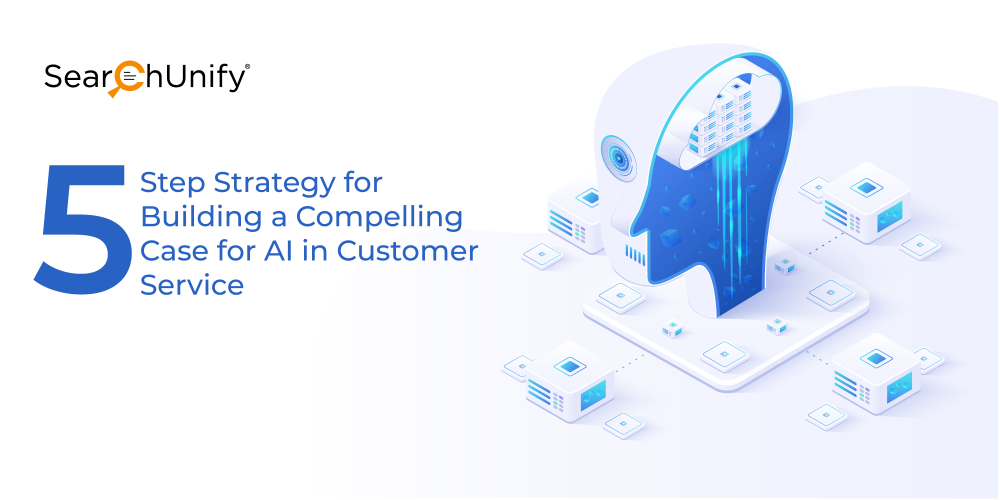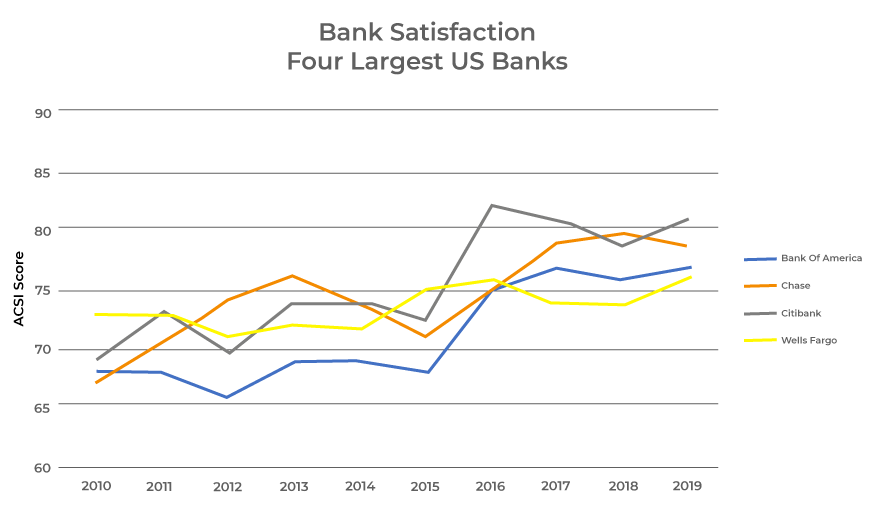
“Gartner predicts that by 2022, 70% of customer interactions will involve AI-emerging technologies such as machine learning (ML) applications, chatbots and mobile messaging, up from 15% in 2018.”
Artificial Intelligence is no longer an idea of the future – it’s a reality!
Many leaders are coming to grips with finding new ways to leverage AI’s full potential for delivering delightful experiences. After all, they’ve witnessed AI doing some incredible work and want to reap the benefits it offers. Let me walk you through one of its many success stories.
According to ACSI, Bank of America (BoA) struggled more with low customer satisfaction ratings for a long time as compared to the other US banks. In 2012, the bank received an ACSI rating of 66, “reaching its lowest level of customer satisfaction in over a decade.” (As shown below)

Source : ACSI
But that is followed by a seismic shift between 2012 and 2019. You might be wondering, “How did this miracle happen? What measures did BoA take to tackle the elephant in the room?”
Holly O’Neill, Chief Client Care Executive – BoA, explained:
“Between 2013 and 2015, Bank of America pivoted from a product and fee-driven approach to a more relationship-driven approach that focused on the expertise of our people and our innovative technology. We like to call this our high-tech and high-touch approach.”
This ‘high-tech and high-touch approach’ improved BoA’s ratings significantly. And as it turns out, it was AI all along. Clearly, what it can do for you in terms of automation, hyper-personalization, customer engagement & delight is remarkable.
The Future of AI & Customer Support in Post-Pandemic World
There is no denying that AI in the support industry was often equated to a single use case – chatbots. However, the pandemic unveiled how it can be leveraged throughout the customer journey and communication lifecycle with cutting-edge cognitive apps to intelligently build long-term relationships.
Despite that, some companies are still holding back from adopting AI or fully embracing this game-changing technology. They refuse to accept it as a worthwhile investment. Well, the facts below suggest otherwise.
“As per Gartner research, despite the global impact of COVID-19, 47% of AI investments were unchanged since the start of the pandemic and 30% of organizations planned to increase such investments, according to a Gartner poll. Only 16% had suspended AI investments, and just 7% had decreased them.”
In fact, AI has now become more important than ever. How, you may ask? The pandemic disrupted business environments globally and the consequences were sudden and severe. Lack of in-person support, lack of IT infrastructure and social structure, adjustment to remote-working norms, clustered self-service knowledge base, etc., are some of the issues that companies are still juggling. This tangles both customers and agents to experience support inefficiency.
Fortunately, embedding cognitive technology and AI can boost the support experience for both your customers and agents. Let’s find out how.
1. Intelligent Search Functionality
A majority of the agents are unable to find relevant information at the right time. As a result, both customers and reps bear the brunt of poor content findability.
Intelligent search on agent consoles allows your service reps to smartly sift through the cornucopia of information, even when it is scattered across disparate sources – feeding users with relevant results in a matter of seconds.
2. Predictive Personalization
One thing that today’s customers are not lacking is ‘choice’. If one company fails to meet the service expectations, another company is right there to swoop in to deliver quick, convenient, and effortless customer support.
“As per Live Chat Benchmark report, the average wait time for chat is 45 seconds.”
Apps like Agent Helper can prevent that. They act as an inline assistant that aids the customer support teams by cultivating a proactive and personalized CX by analyzing user journeys and predicting customers’ needs.
3. Sentiment Analysis & Prioritization
Ticket management and internal routing enable streamlined workflow like nothing else. And with apps like Escalation Predictor, any business can extend this facility.
The smart application identifies and prioritizes tickets with tell-tale signs of an escalation. With in-built Intelligent routing, it can gauge case sentiments and assign the best-fit agent for a speedy resolution.
How Support Leaders Can Make a Business Case for AI
We learned how AI has swiftly disrupted the customer service space. Now, it is time to reap its benefits and advance your support organization by outdistancing your competition. For that, making a solid and persuasive business case around AI is paramount.
Here is a step-by-step approach for building a compelling yet impeccable business case for modernizing your support experiences with an effective ROI framework to get your executive buy-in. Let’s begin.
Step 1: Determine Goals & KPIs
Different companies have different needs. Every firm must look at AI through the lens of business capabilities rather than technologies.
Quantifying your customer support KPIs with a strong focus on human experiences is a great starting point. Interview your agents one by one to track their pain points. After that, you can track a day in an agent’s life and see what challenges they face. Determine the problems and set the business goals like reducing MTTR, lowering caseload, increasing customer retention/loyalty, increasing customer satisfaction, etc.
Step 2: Build an Effective Framework
Now that you have identified business goals and KPIs, it’s time to create an effective framework that outlines value additions AI is bringing to the table. Calculate the financial value of each KPI or business outcome with the adoption of AI.
It is crucial because the finances are the focal point for tension and debate at the higher levels of the organization. That’s why it is better to be prepared for every question beforehand. For instance, what will be the financial impact on the organization if the agents do not have to bear the brunt of poor content findability, leading to quick case resolution. So, the TTR may decrease by 20% which in turn lowers the cost per ticket by 15%.
Step 3: Calculate ROI
In the SaaS industry, there are two departments: Cost Centers and Profit Centers. Customer Service is considered a cost center as it does not produce profits directly. That makes it all the more important to justify the AI budget.
AI opens a wealth of promising opportunities, but it does not guarantee success, especially if unrealistic expectations are set. Measuring the ROI of AI adoption will put you on the right track and give you a stronger hand to play in the budget meetings. Calculate and showcase how AI can transform your organization with long-term profitability throughout the project.
Step 4: Communicate the Stakes Properly
To level up automation in your organization, it is important to communicate the benefits of ushering in a new and modern way to provide customers with the best possible experience.
Some figures, facts, and data can go a long way in reinforcing your points. For instance, people may have their dreams and reservations about AI. Hence, every point should be well-thought-out and well-articulated.
Step 5: Gather Feedback and Improvise
After presenting your proposal to stakeholders, there can be some feedback. Listen carefully and incorporate what seems relevant. Tailor the solution specifically and organize a detailed outline of a plan with proper timelines/milestones. Rewrite the proposal as necessary to make it interesting, helpful, clear, and persuasive.
Want to Augment Your Support Organization with AI?
Customer support is growing by leaps and bounds. AI is coming to change the way businesses support their customers for good. And the sooner you jump on this bandwagon, the better will be the results.
You can start small. For instance, you can test the waters by limiting AI integrations to your agent’s support desk. See how it pans out and decide accordingly. Want to know you can do that? This handy webinar explains how AI can help you build the ultimate agent desk.

















